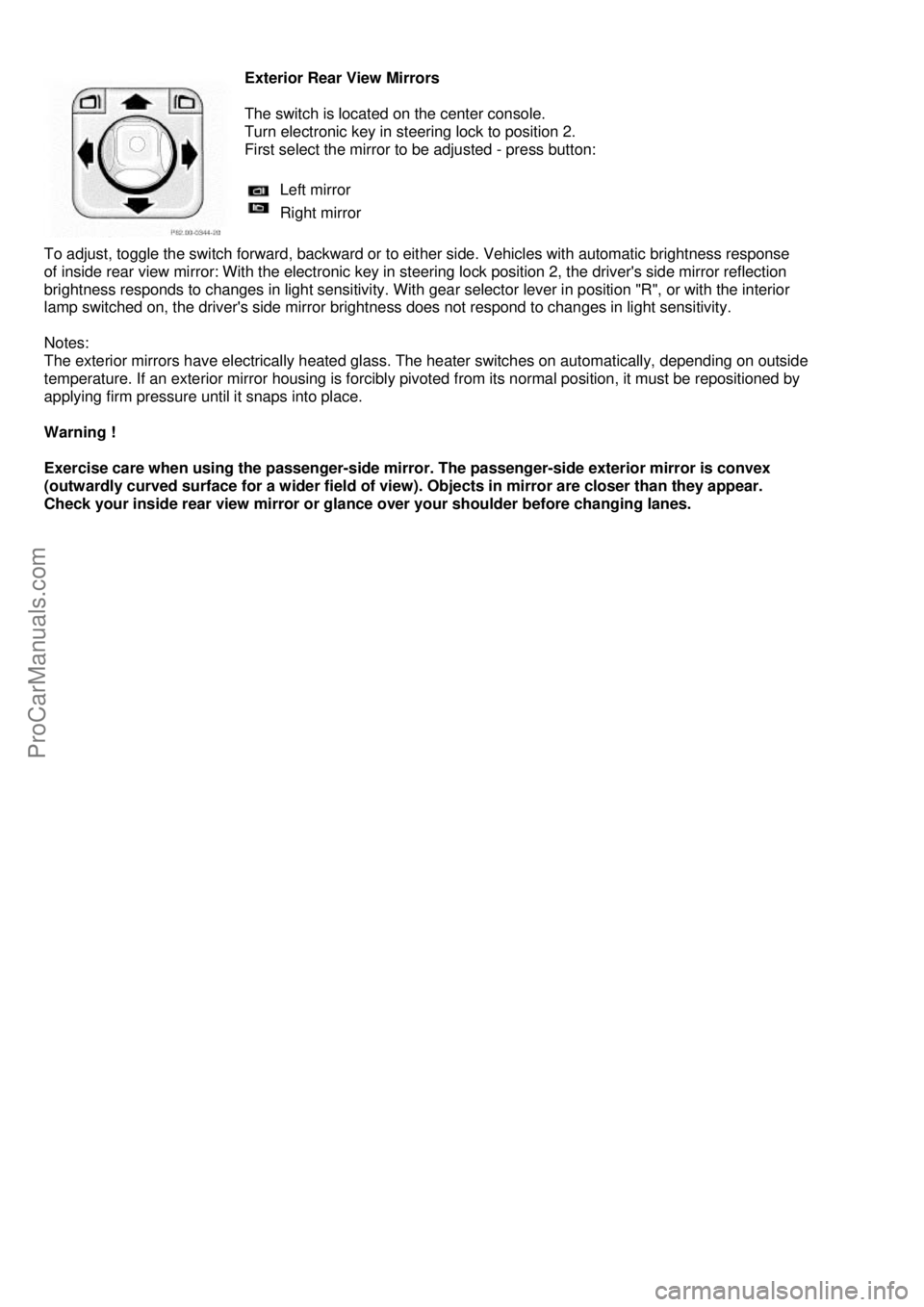1999 MERCEDES-BENZ C-280 warning
[x] Cancel search: warningPage 38 of 122

Airbags
1. Driver airbag
2. Front passenger airbag
3. Side impact airbag
The most effective occupant restraint system yet developed fo
r use in production vehicles is the seat belt. In some
cases, however, the protective effect of a seat belt can be further enhanced by an airbag. The driver airbag is located
in the steering wheel hub. The passenger airbag is located in the dashboard ahead of the passenger.
The side impact airbags are located in the front doors. In conjunction with wearing the seat belts with emergency
tensioning retractors, the airbags can provide increased protection for the driver and passenger in certain major
frontal or rear impacts (for front airbags) and side impacts (for side impact airbags). The operational readiness of the
airbag system is verified by the indicator lamp "SRS" in the instrument cluster. If no fault is detected, the lamp will go
out after approximately 4 seconds; after the lamp goes out, the system continues to monitor the components and
circuitry of the airbag system and will indicate a malfunction by coming on again.
The following system components are monitored or undergo a self-check: crash-sensor(s), airbag ignition circuits,
front seat belt buckles, emergency tensioning retractors, seat sensor (when present). Initially, when the electronic key
is turned from steering lock position 0 to positions 1 or 2, malfunctions in the crash-sensor are detected and indicated
(the "SRS" indicator lamp stays on longer than 4 seconds). In the operational mode, after the indicator lamp has gone
out following the initial check, interruptions or short circ uits in the airbag ignition circuit and in the driver and
passenger seat belt buckle harnesses, and low voltage in the entire system are detected and indicated.
Warning !
In the event a malfunction of the "SRS" is indicated as outlined above, the "SRS" may not be operational. For
your safety, we strongly recommend that you visit an authorized Mercedes-Benz dealer immediately to have
the system checked; otherwise the "SRS" may not be activated when needed in an accident, which could
result in serious or fatal injury, or it might deploy unexpectedly and unneccesarily which could also result in
injury.
Front Airbags
The driver and passenger front "SRS" airbags are designed to activate only in certain frontal or rear impacts.
The front passenger airbag deploys only if the passenger seat is occupied.
Note:
Heavy objects on passenger seat can cause the front airbag to deploy in a crash.
Side Impact Airbags
The side impact "SRS" airbags are designed to activate onl y in certain side impacts. Only the side airbag on the
impacted side of the vehicle deploys. The side impact ai rbag for the front passenger deploys only if the seat is
occupied. Side impact airbags operate best in conjunct ion with a properly positioned and fastened seat belt.
Note:
Heavy objects on passenger seat can cause the side impact airbag to deploy in a crash
ProCarManuals.com
Page 39 of 122

Important !
The "SRS" airbags are designed to activate only in certain frontal or rear (front airbags) impacts, or side (side
airbags) impacts. Only during these types of impacts, if of sufficient severity to meet the deployment
thresholds, will they provide their supplemental protection. The driver and passenger should always wear the
seat belts, otherwise it is not possible for the airbags to provide their intended supplemental protection. In
cases of other frontal impacts, angled impacts, roll-overs, other side impacts, rear collisions, or other
accidents without sufficient forces, the airbag will not be activated. The driver and passengers will then be
protected by the fastened seat belts. We caution you not to rely on the presence of an airbag in order to
avoid wearing your seat belt. The "SRS" is designed to reduce the potential of injury in certain frontal and
rear (front airbags) impacts, and side (side airbags) impacts which may cause significant injuries, however,
no system available today can totall y eliminate injuries and fatalities.
The activation of the "SRS" temporarily releases a small amount of dust from the airbags. This dust,
however, is neither injurious to your health, nor does it indicate a fire in the vehicle. The service life of the
airbags extends to the date indicated on the label located on the driverside door latch post. To provide
continued reliability after that date, they should be inspected by an authorized Mer cedes-Benz dealer at that
time and replaced when necessary.
Warning!
It is very important for your safety to always be in a properly seated position and to wear your seat belt.
For maximum protection in the event of a collision always be in normal seated position with your back
against
the seat back. Fasten your seat belt and ensure that it is properly positioned on the body. Since the airbag
inflates with considerable speed and force, a proper seating and hands on steering wheel position will help
to keep you in a safe distance from the airbag:
• Sit properly belted in an upright position with your back against the seat back.
• Adjust the driver seat as far as possible rearward , still permitting proper operation of vehicle controls.
• Do not lean with your head or chest close to the steering wheel or dashboard.
• Keep hands on the outside of steering wheel rim. Placing hands and arms inside the rim can increase the
risk and potential severity of hand/arm injury when airbag inflates.
• Adjust the front passenger seat rearward as far as possible from the dashboard when the seat is occupied.
• Children 12 years old and under must never ride in
the front seat, except in a Mercedes-Benz authorized BabySmart™ compatible child seat, which operates
with the BabySmart™ system installed in the vehicle to deactivate the passenger side front airbag when it
is properly installed. Otherwise they will be struck by the airbag when it inflates in a crash.
If this happens, serious or fatal injury will result . Failure to follow these instructions can result in severe
injuries to you or other occupants.
Safety Guidelines for the Seat Belt, Emergency Tensioning Retractor and Airbag
Warning !
• Damaged belts or belts that were highly stressed in an accident must be replaced and their anchoring
points must also be checked. Use only belts installed or supplied by an authorized Mercedes-Benz dealer.
• Do not pass belts over sharp edges.
• Do not make any modification that could change the effectiveness of the belts.
• The "SRS" is designed to function on a one-time-only b asis. An airbag or emergency tensioning retractor
(ETR) that was activated must be replaced.
• No modifications of any kind may be made to any components or wiring of the "SRS". This includes
the installation of additional trim material, ba dges etc. over the steering wheel hub, front passenger
airbag cover, or front door trim panels, and in stallation of additional electrical/electronic equipment on
or near "SRS" components and wiring.
• An airbag system component within the steering wheel gets hot
after the airbag has inflated.
• Improper work on the system, including incorrect
installation and removal, can lead to possible injury
through an uncontrolled activation of the "SRS".
• In addition, through improper work there is the risk of rendering the "SRS" inoperative. Work on the
"SRS" must therefore only be performed by an authorized Mercedes-Benz dealer
When you sell the vehicle we strongly urge you to give notice to the subsequent owner that it is equipped with an
"SRS" by alerting him to the applicable section in the Owner's Manual.
ProCarManuals.com
Page 40 of 122

Infant and Child Restraint Systems
We recommend that all infants and children be properly restra ined at all times while the vehicle is in motion. All lap-
shoulder belts except driver seat have special seat belt re tractors for secure fastening of child restraints. To fasten a
child restraint, use this seat belt: Follow child restraint in structions for routing. Then pull shoulder belt out completely
and let it retract. The belt is now locked. Push down on child restraint to take up any slack.
Important !
The use of infant or child restraints is required by law in all 50 states and all Canadian provinces. Infants and small
children should be seated in an appropriate infant or child restraint system properly secured by a lap-shoulder belt,
and that complies with U.S. Federal Motor Vehicle Sa fety Standard 213 and Canadian Motor Vehicle Safety Standard
213.1. A statement by the child rest raint manufacturer of compliance with this standard can be found on the
instruction label on the restraint and in the instruction manual provided with the restraint. When using any infant or
child restraint system, be sure to carefully read and follow all manufacturer's instructions for installation and use.
Please read and observe warning labels affixed to inside of vehicle.
Warning !
Children 12 years old and under must never ride in the front seat, except in a Mercedes-Benz authorized
BabySmart™ compatible child seat, which operates with the BabySmart™ system installed in the vehicle to
deactivate the passenger side front airbag when it is properly installed. Otherwise they will be struck by the
airbag when it inflates in a crash. If this happens, serious or fatal injury will result.
The back seat is the safest place for children, infants and small children must ride in back seats and be
seated in an infant or child restraint system, which is properly secured with the vehicle's seat belt, fully in
accordance with the seat manufacturer's instructions.
Infants and small children should never share a seat belt with another occupant. During an accident, they
could be crushed between the occupant and seat belt. Children too big for child restraint systems must ride
in back seats using regular seat belts. Position shoulder belt across chest and shoulder, not face or neck. A
booster seat is necessary to achieve proper belt positioning for children from 41 Ibs. to the point where a
lap/shoulder belt fits properly without one.
When the child restraint is not in use, remove it from the car or secure it with the seat belt to prevent the
child restraint from becoming a projectile in the event of an accident.
U.S.A. Models only:
Since 1986 all U.S. child restraints comply with U.S. regulations without the use of a tether strap. Canada Models
only: This vehicle is provided with tether anchorages for a top tether strap. Consult your authorized Mercedes-Benz
dealer for installation of these anchorages. In compliance with Canadian Motor Vehicle Safety Standard 210.1, child
restraint tether anchorage hardware is attached to the tool kit located in the trunk.
ProCarManuals.com
Page 41 of 122

1. Locking handle, left backrest
2. Locking handle, right backrest
3. Pass-through
4. Indicator, right backrest lock,
visible in unlocked position
5. Indicator, left backrest lock,
not visible in locked position
Enlarged Cargo Area .
Split Folding Rear Seat Backrest
On vehicles with optional split folding rear seat back rest you can fold down the two sections separately
to enlarge the cargo area.
Fold down:
Pull locking handle and fold backrest forward.
Set up:
Pull backrest up until it locks in its upright position. Check for secure locking by pushing and pulling on
the backrest.
Warning !
Always lock backrest in its upright position when rear seat bench is occupied by passengers,
cargo is being carried in the trunk, or the extended cargo area is not in use.
Note:
To prevent unauthorized persons from access to the trunk, always lock backrest in its upright position.
ProCarManuals.com
Page 42 of 122

Loading instructions
(Vehicles with enlarged cargo area)
The total load weight including vehicle occupants and luggage/ cargo should not exceed the vehicle capacity weight
indicated on the certification tag which can be found on t he left door pillar. The handling characteristics of a fully
loaded vehicle depend greatly on the load distribution. It is therefore recommended to load the vehicle according to
the illustrations shown, with the heavie st items being placed towards the front of the vehicle. Always place items
being carried against front or rear seat backrests, and fast en them as securely as possible. The heaviest portion of
the cargo should always be kept as low as possible since it influences the handling characteristics of the vehicle.
Notes:
The trunk is the preferred place to carry objects. T he enlarged cargo area should only be used for items which
do not fit in the trunk alone.
Warning !
In an accident, during hard braking or sudden maneuvers, loose items will be thrown around inside the
vehicle, and can cause injury to vehicle occupants unless the items are securely fastened in the vehicle.
To help avoid personal injury during a collision or sudden maneuver, exercise care when stowing things.
Put luggage or cargo in the trunk if possible. Do not pile luggage or cargo higher than the seat backs.
Do not place anything on the shelf below the rear window. Never drive vehicle with trunk lid open while
pass-through is not closed and seat backrest not locked in its upright position. Deadly carbon monoxide
(CO) gases may enter vehicle interior resulting in unconsciousness and death.
ProCarManuals.com
Page 43 of 122

Cargo Tie-Down Rings
(Vehicles with enlarged cargo area)
1. Ring
Carefully secure cargo by applying even load on all four rings
with rope of sufficient strength to hold down the cargo.
Shelf below Rear Window
Warning!
The shelf below the rear window should not be used to carry objects. This will avoid such
objects from being thrown about and injuring vehicle occupants during an accident or
sudden maneuver.
ProCarManuals.com
Page 44 of 122

Steering Lock
0 - The electronic key can be withdrawn in this position only. The steering is locked with the electronic key removed
from the steering lock. The electronic key an be removed only with the selector lever in position "P" and the foot
off the brake pedal. After removing the electronic key or with the electronic key in steering lock position 0, the
selector lever is locked in position "P".
1 - Steering is unlocked. (If necessary, move steering wheel s lightly to allow the electronic key to be turned clockwise
to position 1.) Most electrical consumers can be operated. For detailed information see respective subjects.
2 - Driving position.
3 - Starting position.
Refer to Index for Starting and turning off the engine.
Warning !
When leaving the vehicle always remove the electroni c key from the steering lock, and lock the vehicle.
Do not leave children unattended in the vehicle, or with access to an unlocked vehicle.
Unsupervised use of vehicle equipment may cause serious personal injury.
Important !
If the electronic key is left in the steering lock position 0 for an extended period of time, it can no longer be turned in
the lock. In this case, remove electron ic key from steering lock and reinsert.
Notes:
A warning sounds when the driver's door is opened with the el ectronic key in steering lock position 1 or 0. With the
engine at idle speed, the charging rate of the alternator (output) is limited. It is therefore recommended to turn off
unnecessary electrical consumers while driving in stop-and-go traffic. This precaution helps to avoid draining of the
battery. Unnecessary strain on the batte ry and charging system may be minimized by turning off the following power
consumers, for example: Heated seats, rear window defroster. In addition, the automatic climate air volume control
should be set to the lowest position. The steering lock can only be unlocked with the vehicle battery properly
connected.
Caution !
To prevent accelerated battery discharge and a possible dead battery, always remove the electronic key from the
steering lock. Do not leave the electronic key in steering lock position 0.
ProCarManuals.com
Page 49 of 122

Exterior Rear View Mirrors
The switch is located on the center console.
Turn electronic key in steering lock to position 2.
First select the mirror to be adjusted - press button:
Left mirror
Right mirror
To adjust, toggle the switch forward, backward or to eit her side. Vehicles with automatic brightness response
of inside rear view mirror: With the electronic key in st eering lock position 2, the driver's side mirror reflection
brightness responds to changes in light sensitivity. With gear selector lever in position "R", or with the interior
lamp switched on, the driver's side mirror brightne ss does not respond to changes in light sensitivity.
Notes:
The exterior mirrors have electrically heated glass. The heater switches on automatically, depending on outside
temperature. If an exterior mirror housing is forcibly pivot ed from its normal position, it must be repositioned by
applying firm pressure until it snaps into place.
Warning !
Exercise care when using the passenger-side mirror. The passenger-side exterior mirror is convex
(outwardly curved surface for a wider field of view). Objects in mirror are closer than they appear.
Check your inside rear view mirror or glance over your shoulder before changing lanes.
ProCarManuals.com